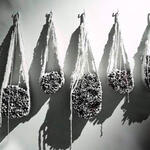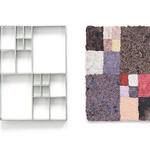Paloma Torres
Bio
Born in Mexico City in 1960. She obtained her Bachelor’s degree in Visual Arts from the National School of Plastic Arts of UNAM (National Autonomous University of Mexico), where she also earned a Master’s degree in color engraving.
Paloma Torres attended a course in color intaglio printing, at the Atelier 17 run by S.W. Hayter, in Paris, as well as professional printing course with Professor Carlos García. In 2013 took Ceramic Printing Techniques with the Argentinian artist Graciela Olio. He has carried out various artistic residencies in Mexico and abroad, among others the following stand out: Nirox Sculpture Park in South Africa (2020), She has taken several artistic residencies in Mexico and abroad, among others noted are: the Felting workshop in Casa de las Artes (CaSa) in San Agustín Etla, Oaxaca, México (2013 and 2014); in the Visva Bharati University in Shantiniketan ,Bengala, Calcuta (2012); with the master René Derouin, in Quebec, Canadá (2011); in Innsbruck, Austria en 2010; in the Mexican Ceramics Art Museum in Fuping, Shaanxi, China (2007) and the Cité Internationale des Arts in Paris, France (2000). She has more than one hundred collective exhibitions and fifty-five individual exhibitions, noting the most relevant the ones held in: the Carrillo Gil Art Museum, Palace of Fine Arts in Mexico City, Amparo Museum in Puebla, among others. Her Urban Patterns exhibition took place in Paris, Berlin, Beirut, Doha, Kuwait, Bangkok and San Francisco. In June 2017 was curator of the “Clay in transit” Exhibition in the Mexican Cultural Institute of Washington D.C., this collective where she also showed her work travelled trough USA cultural centers, the last one of them the Newcomb Museum Tulane University in Louisiana. In 2018, Paloma Torres presented her work in diverse collective exhibitions along Mexico where she shows different collaborations with artists, associations and museums such as Francisco Toledo and the UNESCO. In 2019 she presented her exhibit “Recreaciones Urbanas” (Urban Recreations) in the Capilla del Arte in Puebla, Mexico and the collective exhibit “Escultura de la Tierra. Cerámica Mexicana” (Earth Sculpture. Mexican Ceramics) in Los Pinos Cultural Complex, in Mexico City. and in 2020 this same exhibition at the Oaxaca Textile Museum. He is currently presenting a individual exhibition, “El hilo de la tierra”, at the Seminario de cultura Mexicana, in Mexico City. Paloma was art professor at the Iberoamerican University in Mexico City, and in the National School of Painting, Sculpture and Engraving “La Esmeralda”. And has given courses in other academic institutions in the country and abroad, where she has also participated as lecturer, such as the diverse workshops held in the CaSA and the Canela Workshop, both in Oaxaca, México; in the Chulalongkorn University in Thailand, among others. She was member of the National System for Creative Artists (FONCA), since 2013 is part of the Arts and Letters Council of the Mexican Museum of San Francisco, California and in 2014 become a member of the International Academy of Ceramics (AIC/IAC).
Among the awards she has received, of particular note are: Honorable Mentions in the IV Ceramics Biennial in Korea; and in the Sculpture Triennial in Mexico City; the art intervention for the Elena Garro Cultural Center in Mexico City and the big lattice wall for the Tlatelolco Museum; the commemorative sculpture for the 700th years of the Swiss Confederation in the city of Cumbel, Switzerland. In 2017 her sculpture “City Totem” was the selected pieces to represent Mexico in the APEC forum, to be exhibited permanently in the Park Project in Vietnam. Her work is part of many Public and Private Collections such as the De Young Museum in San Francisco, California, USA; The Museum of Mexican Ceramic Art in Fuping, Shaanxi, China; Daniela Chappard Foundation in Caracas, Venezuela; the Amparo Museum in Puebla, Mexico; the Museum of Modern Art in Mexico City; Ponce Art Museum in San Juan de Puerto Rico; Manuel Felguérez Abstract Art Museum in Zacatecas, Mexico; the University Museum of Contemporary Art (MUAC) in Mexico City; the National Auditorium Art Collection in Mexico City. APEC Vietnam Park, DaNang, Vietnam. Galerie Nothburga, Innsbruck, Austria; Carrillo Gil Museum, Mexico City; National Auditorium Art Collection in Mexico City, among others.
Statement
I was born in México City in 1960. At 21, I began exploring ceramics as a student in the National School of Visual Arts [1]. From that day on, I have not ceased been fascinated by clay. I soon realized that, besides technical mastery, this material requires being understood as a total PROCESS: a full bodily and conceptual comprehension of multiple variables by which argil is reconstituted into tridimensional entities.
Direct involvement with materials is an essential part of my work. The daily task of constructing a piece leads me to think it and rethink it. The conjunction between the physical limits and my desire to articulate its development allows me to evolve from the initial concept to the finished product. Yet, the greatest challenge to overcome is that no matter how I build or how I paint a sculpture, materials have a way of expressing themselves; there will always be an element of surprise: sheer luck. Fire, after all, does have the final word.
As an artist, understanding working processes has guided me into discovering other media. Therefore, my sculptures are also made out of bronze, wood, metal, concrete and even out of felt. Through these diverse techniques I have come to embrace volume as well as bidimensional representation; thanks to my experience in graphics, my production has also been enriched towards drawing, textiles and relief.
The city is one of my greatest passions. As I was born in a family of architects, space naturally became the most important element in my worldview. Ever since I was a child, I learnt to discover that plazas and buildings were not alien to us, but the flexible stage that made our daily life activities possible. Being a sculptress, I am certain that the spirit of every community is forged -precisely- in the interaction among extensions and structures. Cultivating and preserving this vital dialogue between open and enclosed spaces is not only an artistic responsibility, but a necessary human commitment, in order to construct healthy societies.















